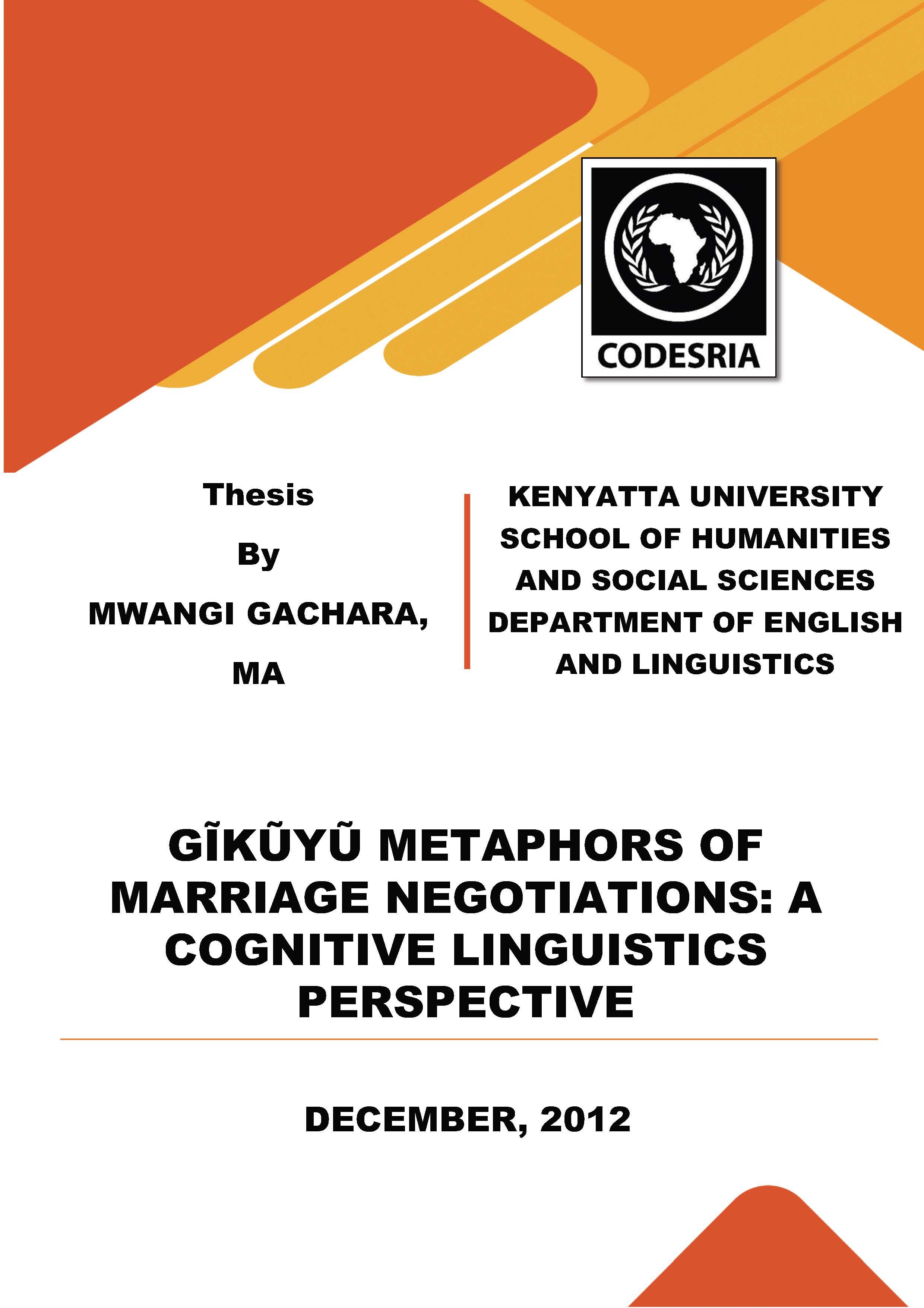GĨKŨYŨ METAPHORS OF MARRIAGE NEGOTIATIONS: A COGNITIVE LINGUISTICS PERSPECTIVE
Mots-clés :
the Gĩkũyũ marriage, COGNITIVE, LINGUISTICSSynopsis
This study identifies, describes, and analyses the metaphors used in the Gĩkũyũ marriage negotiations from a cognitive linguistics perspective.
We audio-recorded discourse from two marriage negotiation gatherings followed by transcription of data and then identification of metaphorically used items. This meant that we subjected all the lexical items collected to the MIPVU to find out which were metaphorical in nature. These metaphors were then analysed in terms of their linguistic form and conceptual structure. The linguistic form looked at which ones were incomplete, rhetorical, shortened or even lengthened, classic, distended or extended.
The conceptual structure looked at whether the metaphorical item is novel (new), conventional (old) or even borderline. This was determined by the respondents‘ interpretation, researcher‘s intuition vs. the research assistant‘s yardstick. The respondents are varied in the social variables of age, sex, and educational level. Lastly, we wanted to find out the extent to which these metaphors can be accounted for within the Career of Metaphor Theory. For each of the three social variables under investigation, we had three respondents, meaning that our population sample had a total 24 respondents.
From the metaphors we collected from the context of marriage negotiations we sampled 20 metaphorical items from each negotiation. It is these 40 metaphorical items that we presented to the twenty four (24) respondents to collect further data
through a questionnaire that sought their interpretation and their level of familiarity with the given metaphors.
In the analysis of the metaphors so collected, we also investigated which ones were understood as comparisons and which ones were understood as categorisations so as to account for the evolution of metaphors, for this is a key tenet in the Career of
Metaphor Theory, our objective number four. The Career of Metaphor Theory helped us in identifying the base and target domains for conventional metaphors and the topic, superordinate and subordinate vehicle concepts for novel metaphors. We then determined the extent to which the theory accounts for Gĩkũyũ metaphors of marriage.
Using the chi square test, the variance in linguistic form, conceptual structure and metaphor interpretation using the variables of age, sex, and level of education were analysed.
We found that metaphors used in marriage negotiations largely treat women as objects and organisms which commodify women. Men on the other hand are treated like weapons of war in turn informing the concept SEX IS WAR. We also found that love is rarely talked about.
We recommend the replacement of negative metaphors with positive one that draw from the PATH and FAMILY domains to give both women and men an equal footing. This thesis is divided into five chapters. Chapter one covers the introduction; chapter two, literature review and theoretical framework; chapter three, research methodology; chapter four, data analysis and data presentation; and chapter five has findings, recommendations and conclusion.
Téléchargements
Références
Achebe, C. (1958). Things Fall Apart. EAEP: Nairobi.
Austin, J. (1962). How to Do Things with Words. Claredon: Oxford.
Barlow, J., Kerlin, J., and Pollio, H. (1971). ―Training manual for identifying figurative Language‖. Technical report #1. Metaphor Research Group, University of Tennessee.
BBC NEWS, Tuesday, 25th July, 2000.
BBC world Service, 14th June, 2009
Berber Sardinha, T. (2006, April 10–12). A tagger for metaphors. Paper given at the sixth
Researching and Applying Metaphor (RaAM) Conference, Leeds University.
Bible, King James Version.
Blumberg, M. (2002). Body Heat. Cambridge Mass.: Harvard University Press.
Boers, F. (1999). ―When a bodily base domain becomes prominent: The joy of counting metaphors in the socio-economic domain‖. In R.W. Gibbs, Jr., and G. J. Steen (Eds.), Metaphor in cognitive linguistics (p. 47–56). Amsterdam: John Benjamins.
Borodisky, L. (2000). Metaphoric Structuring: Understanding time through spatial metaphors. Cognition, 75, 1 – 28.
Bowdle, B. F., and Gentner, D. (2001). The career of metaphor: Patterns of change in figurative language and figurative thought. Hillsdale, New Jersey: Lawrence Erlbaum.
Bowdle, B., and Gentner, D. (2005). The Career of Metaphor. Psychological Review, 112, 195 – 216.
Cameron, L. (1999). Identifying and describing metaphor in spoken discourse data. In L. Cameron and G. Low (1999) (Eds.), Researching and applying metaphor (p. 105– 132).
Cambridge, UK: Cambridge University Press.
Cameron, L. (2003). Metaphor in educational discourse. London: Continuum.
Cameron, L. (2007). Patterns of Metaphor use in Reconciliation Talk. Discourse and Society, (vol 18(2): 197- 222.) London.
Cameron, L., and Stelma, J. (2004). Metaphor clusters in discourse. Journal of Applied Linguistics, 1(2), 7–36.
Cameron, L. (2007). Patterns of Metaphor use in Reconciliation Talk. Discourse and Society, vol 18(2): 197- 222.






